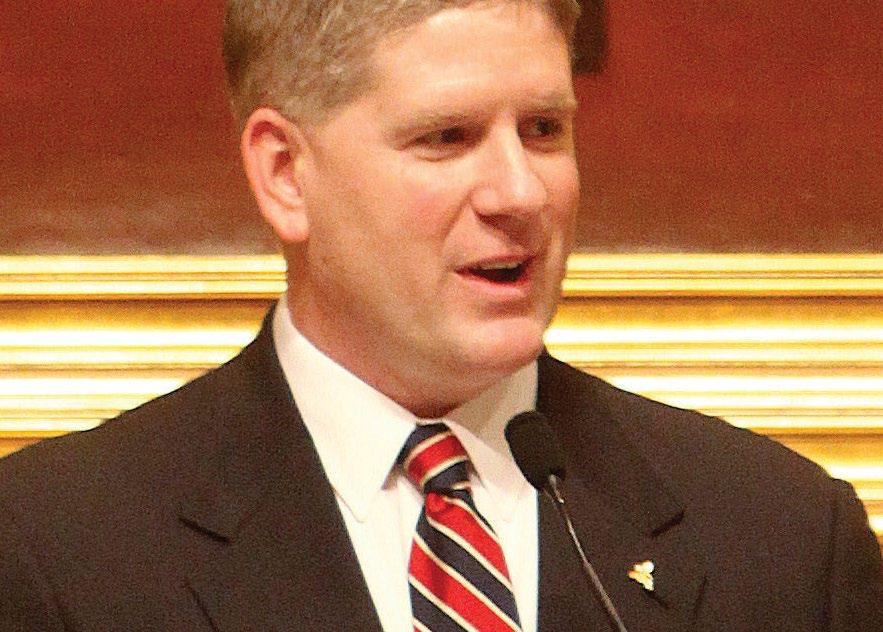
17 minute read
SHRINKING GOVERNMENT
Wants & Needs Meet
What Government Can Afford
States Strive to Find a ‘New Normal’ in Providing Services by Mary Branham
When Jennifer Granholm was governor of Michigan, she had to make cuts in state government—a lot of cuts.
“It was two terms of shrinking the size of government and dealing with the shrinkage of tax revenues … from the contraction in our economy,” Granholm said.
She cut nearly $15 billion of state spending, shrinking the size of Michigan state government by 13 percent, more than any state in the country, from the turn of the century to the end of her second term in 2011.
It was necessary, but it wasn’t easy.
Granholm and others believe many people elected with a promise of shrinking state government, cutting taxes and eliminating waste are finding out just how difficult it is.
“The kill government and drown government crowd, I just don’t think are living in reality,” she said. “We have to fund not just the jobs but the services those jobs provide.”
But states are required to balance their budgets, and funding those jobs and services takes an increasing amount of money, as everything from health care costs to fuel prices rise. With the Tea Party wave taking hold in state legislatures in 2010 with promises to cut or maintain current taxes, states across the country have had to find a way to shrink the government as well.
Cutting Taxes
As states pull out of the Great Recession, some policymakers have proposed slashing taxes or changing the tax code as a way to attract more businesses to the state and/or offer some relief to taxpayers.
But that’s treading on dangerous ground, according to economist Bill Fox, director of the Center for Business and Economic Research at the University of Tennessee. Fox studies state tax policy.
He said states are seeing an increase in tax revenues because of economic growth. Policymakers can feel comfortable in cutting taxes now, he said, because revenues are growing pretty well and growth rates and revenues are pretty strong.
“This sort of happened—not to the same degree—after the previous recession of 2004–05,” he said, “where states were cutting tax rates because they were on the upside of the business cycle.
“When the recession came, it was, ‘Oh, shoot, what do we do now?’”
Business cycles happen, Fox said. “If you’re on the upside, there will be a downside. States may be sorry that they’ve made those adjustments.”
But several states have made such adjustments. The Kansas legislature passed a bill to reduce individual income taxes and eliminate state taxes on business income claimed on individual returns. Gov. Sam Brownback signed that bill into law in May.
In Oklahoma, however, “The political will to reform the tax code was just not there,” House Speaker Kris Steele told The Associated Press. Gov. Mary Fallin’s plan to slash the top rate of the state income tax from 5.25 percent to 3.5 percent failed.
North Dakota voters in June considered eliminating all property taxes in the state. More than 76 percent of voters rejected the proposal.
By most accounts, North Dakota has weathered the storm of recession better than other states.
“We have a lot of money in North Dakota,” said Joe Miller, vice chairman of the state’s Senate Finance and Taxation Committee. “We’re doing pretty well.
“People see this money and want us to use it to lower their tax burden,” he said.
The problem is this: Property taxes are almost exclusively local, he said. “It’s difficult to lower the property tax burden when the state doesn’t levy any property tax.”
What the state has done is subsidize a share of residents’ local tax bills. That means the state is giving more money to the local school districts. Those districts, in turn, can’t raise rates, he said.
“The price tag keeps going up. We need to make sure we’re cutting taxes, not just padding budgets for people,” he said.
Miller, a Republican, isn’t opposed to cutting taxes.
“We need to cut taxes in this state because we do have the money to do it,” he said. “It’s very important that we cut taxes. We just have to make sure we do it in a way that is equitable, that somebody is not being penalized in the process.”
Miller was concerned about eliminating property taxes in the state and depending solely on a commodity-based tax system.
“The oil revenue that we’re getting needs to be used to fix our infrastructure, update things we haven’t updated in 50 years or more and sock it away for the future so we can keep
WHAT CAN STATES AFFORD?
As state policymakers strive to shrink the size of state government and costs, many must make tough choices about what they can afford. In California, Gov. Jerry Brown proposed eliminating the California Commission on the Status of Women. Academy Award-Winning Actress Geena Davis joined lawmakers at the state Capitol in Sacramento in April to announce new funding for the commission. At right is Assembly Speaker John A. Perez. In Missouri, the University of Missouri Press—where books are shelved in the front hallway of the Columbia, Mo., offices—wasn’t so lucky. The press is scheduled to close this year due to budget cuts.

© AP Photo/ Missourian , Carrie Anne Durkee

—Stuart Drown, executive director
California’s Little Hoover Commission

taxes low for the future,” he said. “That’s the blessing we can get for the oil revenue, but we don’t want to become dependent upon it.”
Changing a state tax system isn’t easy, as policymakers in Oklahoma and Missouri learned this year.
Even in Kansas, where Brownback made cutting taxes his signature issue. The governor started the tax cut debate, but stressed the need for balance in a March news conference.
He said the tax cuts had to be balanced with “pay-fors” to keep the package responsible.
“That’s where you get the tough piece of it,” Brownback said in that statehouse news conference. “It’s easier to say, ‘I’m just for cutting all of this,’ and then, well, what about the hole that’s here in the budget?”
That’s the dilemma that Fox, the Tennessee economist, sees as well.
“It’s foolhardy policy to create tax structures based on revenue performance on the upside of a business cycle,” he said. “There will be a consequence at the other end.”
Shrinking Government
The more responsible way to deal with tough budget situations, Fox believes, is to have a serious discussion about what the states should and should not be doing.
“We need to figure out what government should do and get some sense of that from the expenditure side,” he said, “and we need to set a tax structure to be able to do that and then get out of the way and let government happen.”
While states have talked about shrinking government, few have offered concrete plans about what that really means. Some propose across-the-board cuts that reflect the amount lost with a shrinking revenue stream that comes with cutting or freezing taxes or from contracting economic growth.
“Across-the-board cuts are cop-outs,” said Granholm, the former Michigan governor.
Her cuts came from a scalpel-like precision on the budget. The state fair, a part of Michigan’s long history—gone. The Department of History, Arts and Libraries—no more grants.
“In order to prevent senior citizens from being cut off from Medicaid, … I prioritized health care for senior citizens and children and people with disabilities over that,” she said.
Those are the challenges many governors and legislators are still facing.
Take California, where the state continues to face a $16 billion shortfall.
“This means we will have to go much farther and make cuts far greater than I asked for at the beginning of the year,” Gov. Jerry Brown said in an online video.
Brown is proposing a tax increase, and is asking California voters to decide the issue in November. If voters don’t approve the hike, it will force severe cuts to schools and public safety, Brown said.
Like all California governors, Brown must submit his plan to the state’s Little Hoover Commission, a state organization in its 50th year that is charged with making recommendations to the legislature and governor on how to increase efficiency in executive branch operations.
It’s not an easy task, said Stuart Drown, executive director of the commission.
“Some quarters of government have not accepted the new normal and that’s really complicated the discussion about how to restructure government to make it more efficient and to deliver the level of services that we want to with the resources that we have,” he said.
Part of the California plan shifts some state responsibilities to the county level along with some, but not all, current funding, Drown said. Counties haven’t had the discussion about prioritizing the services.
James Mayer, executive director of California Forward, a nonprofit organization whose mission is to work with Californians to help

© AP/Corbis/Rich Pedroncelli
create a “smart” government, calls the process “a devolution of responsibility.”
Some of it, like the statute that moves the responsibility for offenders from the state to county levels, is intentional, he said.
“Some of it is unintended because the state has stopped paying for things it had been paying for and they’re not necessarily things that people don’t want to do,” he said. “Often times, that means cities and counties are stuck trying to do it.
“The challenge is not just to be devolving, but to be truly realigning and re-engineering.”
Policymakers in some states are proposing to do just that.
Pennsylvania House Speaker Sam Smith, a Republican, proposed shrinking the size of his chamber from 203 seats to 153 seats and shrinking the size of the Senate from 50 to 38.
“In order to right-size Pennsylvania’s government, the legislature needs to put its own house in order,” Smith said in an April press release.
He argued that the legislature-constituent relationship wouldn’t be adversely affected.
“Real time communication with multiple friends and neighbors back in our legislative districts is as different from the telephone system of 1968 as that system was to the Pony Express,” he said in the release.
The Pennsylvania House approved the resolution in April. It is now under consideration in the Senate. Reducing the size of the legislature will require passage in two consecutive sessions, followed by approval from voters.
In other states, major reorganizations have been proposed or completed. In North Carolina, for instance, Gov. Bev Perdue combined three cabinet level agencies to create the Department of Public Safety, the largest agency in state government, that will employ 25,000 people. In Virginia, Gov. Bob McDonnell eliminated 19 state boards and commissions and combined 23 others.
Accepting the New Normal
While all that may help, many believe more action and serious discussions may be needed.
“It’s a matter of what you want to do, what you’re obligated to do and what your resources will allow you to do,” Drown said.
After those decisions are made, Granholm said, leaders must make sure everyone understands what they will get in the way of services.
“You have to be honest with citizens that they cannot have their cake and eat it too, especially in these tough times,” she said. “If they want good schools to send their kids to, then they are not going to be able to have zero taxes. It’s just not going to happen.”
Drown expects the tough decisions facing state policymakers will continue for some time.
“This is the new normal,” he said. “We’re going to have to be scrubbing this budget every year and coming up with new ways every year to do things better. That’s a lot of work and it takes a new approach to government.”
That said, Drown relates the words of former California Gov. Pat Brown at the inaugural meeting of the Little Hoover Commission that he believes are just as relevant today:
“Democracy itself is a process of change, and satisfaction and complacency are enemies of good government.”

—Former Michigan
Gov. Jennifer Granholm
CUTS AND EFFECTS
California Gov. Jerry Brown discussed the cuts he has already made to help reduce the state's budget deficit as he unveiled his proposed $92.5 billion 2012–13 state budget at a Capitol news conference in Sacramento in January. Those affected by state budget cuts often rally to fight for their cause. In photo at far left, parents and child care providers from Illinois rallied for child care funding restoration and against massive budget cuts at the Illinois State Capitol in Springfield in May.

REFORMING GOVERNMENT FROM WITHIN »
© Steven G. Smith / Corbis

© AP Photo/Stacy Bengs
Minnesota House Speaker Targets Change
by Mary Branham
Many credit the shift in several legislative changes from Democrat to Republican control in the 2010 elections to the Tea Party. What do you think convinced voters to make these changes in general, and Minnesota in particular?
“I think there was a focus on the fiscal responsibility, managing the budget a little bit better than it had been done in the past. I would also give a lot of credit, especially in Minnesota, to our candidates. The now majority leader, Matt Dean, and I made a very concerted effort to go out and recruit people that probably weren’t the first to raise their hand and say, ‘Oh yes, I’ve been on city council, then I was mayor and county commissioner and state legislator is the next logical choice.’ We went and found people who were very reluctant.”
And the Tea Party influence?
“The Tea party movement and some of the influences around the country (were) in other states that didn’t have the majority. We had had the (House) majority in 2006. … Those other states hadn’t had Republican (majorities) for decades or generations. … So I would say about 75 percent of our success was based on our candidates and then our candidates also carrying the message to their districts too, which was jobs, the economy, not spending the way we used to.”
What were some of your goals in this legislative session?
“A lot of it focused on reforming government. We had seen time and again, there’s a lot of duplication. … We looked at it from the broader concept of government should not force the taxpayer or business owner, somebody coming to the government for a permit or a license for some sort of objective that the government has to sign off on, they shouldn’t have to chase the government around. The government should tell them where to go. … Our driving principle was to balance the budget without a tax increase and then reform government.”
How did you work to reform government?
“We asked government to help redesign itself. There are a number of initiatives from the business community, from outside agencies, from foundations. We were willing to listen to anybody and everybody who had an idea of how to be more efficient in daily functions. … It was reforming from within. And we also spent a lot of time in the two years prior to being elected to the majority traveling the state and asking business owners, … what is it each and every day that makes it more difficult as a business owner? Without question, it was the bureaucracy. … There was just absolutely no consistency and it was across just about every different kind of agency or service or product.”
What is the best way to shrink government?
“Technology is almost always a good answer. ... We have got to use technology and focus on a smaller workforce today because in the next five years to 10 years, (retirement of many state workers) will be here and then we’ll have to react to the 10 percent cuts or the 11 percent cuts, where this, we can do in a gradual way. If someone is going to retire, we can offer them an early retirement, and we know in six months they’re going to be leaving, it’s easier to then introduce technology or to consolidate those services into one office or one agency versus having them spread out over several (agencies).”
What challenges have you faced in getting some of the goals accomplished?
“With 33 freshmen out of a 72-member majority, there are lots of new people. … Almost half of our caucus has never been involved in putting together a budget at the Capitol, so we had to spend a lot of time answering questions and then building up trust. … Everybody being new to the process is great in a lot of ways, but it also does present those challenges.”
Rep. Kurt Zellers took the reins as speaker of the Minnesota House of Representatives after the 2010 elections put the Republicans in the majority. The shift in House leadership gave Republicans control of both legislative chambers for the first time in decades.
Read the full interview with Kurt Zellers at capitolideas.csg.org.
How has the working relationship changed with the other party?
“In my entire time at the Capitol, on just about every one of the bills that I’ve authored, I’ve had a Democrat co-author on there. I have always worked really well with them whether we were in the majority or I was in the minority. … We have three rules: One, we act like we belong there; two, are no surprises; and the third is to be respectful of everyone at the Capitol, whether it’s our staff, whether it’s Democrat members, Republican members, House or Senate.”
How does having a Democratic governor affect the ideas you present and how you present them?
“It is a challenge in how you present ideas to him. He just looks at it from a different perspective. You have to know the limits and where they just can’t go. We knew that Gov. (Mark) Dayton could not go along with some of the labor reforms. Labor unions were the only people who endorsed him in his campaign. … We knew it would be very hard for him to do anything that would … severely cut or limit or reform the way those unions worked. My challenge is to explain to him that our members got elected, a majority of them … all ran on (the promise that) we’ll balance the budget without raising taxes.”
There’s a lot of discussion about the growing partisanship in Washington, D.C., and spreading to state capitols. Is there still a good civil discourse in the legislative process?
“If you were to ask some reporters or lobbyists, they would probably say it’s just as bad. … We have the same political ideological splits now. We have people on the far right and far left, just as they’ve had since the beginning of politics. … It’s a very serious business that we do, but there are a lot more important things in life than holding a grudge about somebody offering an amendment or the governor vetoing my bill. From my personal perspective, there are very few things that I will take personal, if anything, that would lead me to make sure that some Democrat bill doesn’t come up for a vote or to make it personal with anybody.”
The fiscal situation seems to be improving in many states. What is the situation in Minnesota and to what do you attribute it?
“We are on much better fiscal footing. … Again, it’s bringing the consistency to the business community, whether it’s the small businesswoman who has a small manufacturing plant in central Minnesota or a Cargill or 3M, two of our big legacy Fortune 500 companies. Bringing that consistency to the workforce and also the economy allowed them to feel comfortable that, ‘OK, I’m not going to have more rules. There aren’t going to be more regulations that I have to spend time and money dealing with accountants or lawyers and I’m also not going to have to take money out of R&D or new hires or new acquisitions for taxes.’”










